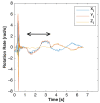Balance Assessment Using a Smartwatch Inertial Measurement Unit with Principal Component Analysis for Anatomical Calibration
- PMID: 37430500
- PMCID: PMC10222509
- DOI: 10.3390/s23104585
Balance Assessment Using a Smartwatch Inertial Measurement Unit with Principal Component Analysis for Anatomical Calibration
Abstract
Balance assessment, or posturography, tracks and prevents health complications for a variety of groups with balance impairment, including the elderly population and patients with traumatic brain injury. Wearables can revolutionize state-of-the-art posturography methods, which have recently shifted focus to clinical validation of strictly positioned inertial measurement units (IMUs) as replacements for force-plate systems. Yet, modern anatomical calibration (i.e., sensor-to-segment alignment) methods have not been utilized in inertial-based posturography studies. Functional calibration methods can replace the need for strict placement of inertial measurement units, which may be tedious or confusing for certain users. In this study, balance-related metrics from a smartwatch IMU were tested against a strictly placed IMU after using a functional calibration method. The smartwatch and strictly placed IMUs were strongly correlated in clinically relevant posturography scores (r = 0.861-0.970, p < 0.001). Additionally, the smartwatch was able to detect significant variance (p < 0.001) between pose-type scores from the mediolateral (ML) acceleration data and anterior-posterior (AP) rotation data. With this calibration method, a large problem with inertial-based posturography has been addressed, and wearable, "at-home" balance-assessment technology is within possibility.
Keywords: balance; biomechanics; calibration; coordinate system discovery; inertial measurement unit; posturography; principal component analysis; smartwatch; wearables.
Conflict of interest statement
The authors declare no conflict of interest.
Figures













References
MeSH terms
Grants and funding
LinkOut - more resources
Full Text Sources
Medical

